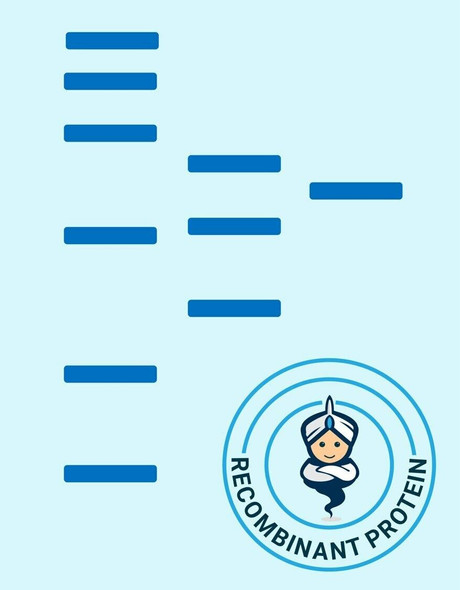Human CD86 Recombinant Protein (RPPB3099)
- SKU:
- RPPB3099
- Product type:
- Recombinant Protein
- Size:
- 20ug
- Species:
- Human
- Target:
- CD86
- Synonyms:
- B7-2/CD86
- CD86
- B7-2
- B72
- Source:
- Sf9 Insect cells
- Uniprot:
- P42081
Description
| Product Name: | Human CD86 Recombinant Protein |
| Product Code: | RPPB3099 |
| Size: | 20µg |
| Species: | Human |
| Target: | CD86 |
| Synonyms: | B7-2/CD86, CD86, B7-2, B7.2, B70, CD28LG2, LAB72, T-lymphocyte activation antigen CD86, Activation B7-2 antigen, B70, BU63, CTLA-4 counter-receptor B7.2, FUN-1. |
| Source: | Sf9 Insect cells |
| Physical Appearance: | Sterile Filtered colorless solution. |
| Formulation: | CD86 protein solution (0.5mg/ml) contains Phosphate Buffered Saline (pH 7.4) and 10% glycerol. |
| Stability: | Store at 4°C if entire vial will be used within 2-4 weeks. Store, frozen at -20°C for longer periods of time. For long term storage it is recommended to add a carrier protein (0.1% HSA or BSA).Avoid multiple freeze-thaw cycles. |
| Purity: | Greater than 90% as determined by SDS-PAGE. |
| Amino Acid Sequence: | YFNETADLPC QFANSQNQSL SELVVFWQDQ ENLVLNEVYL GKEKFDSVHS KYMGRTSFDS DSWTLRLHNL QIKDKGLYQC IIHHKKPTGM IRIHQMNSEL SVLANFSQPE IVPISNITEN VYINLTCSSI HGYPEPKKMS VLLRTKNSTI EYDGIMQKSQ DNVTELYDVS ISLSVSFPDV TSNMTIFCIL ETDKTRLLSS PFSIELEDPQ PPPDHIPHHH HHH |
CD86, also known as B7-2 or Cluster of Differentiation 86 is a protein necessary for T cell activation and survival, it is expressed on cells that are antigen-presenting cells and acts as costimulatory signals for T cells. CD86 is the ligand for CD28 (for autoregulation and intercellular association) and CTLA-4 (for attenuation of regulation and cellular disassociation), two different proteins.
CD86 Human Recombinant produced in Sf9 Baculovirus cells is a single, glycosylated polypeptide chain containing 223 amino acids (31-247a.a.) and having a molecular mass of 25.6kDa (Molecular size on SDS-PAGE will appear at approximately 40-57kDa). CD86 is expressed with a 6 amino acid His tag at C-Terminus and purified by proprietary chromatographic techniques.
| UniProt Protein Function: | CD86: Receptor involved in the costimulatory signal essential for T-lymphocyte proliferation and interleukin-2 production, by binding CD28 or CTLA-4. May play a critical role in the early events of T-cell activation and costimulation of naive T-cells, such as deciding between immunity and anergy that is made by T- cells within 24 hours after activation. Isoform 2 interferes with the formation of CD86 clusters, and thus acts as a negative regulator of T-cell activation. 4 isoforms of the human protein are produced by alternative splicing. |
| UniProt Protein Details: | Protein type:Immunoglobulin superfamily; Membrane protein, integral Chromosomal Location of Human Ortholog: 3q21 Cellular Component: cell surface; intracellular membrane-bound organelle; plasma membrane; integral to membrane; external side of plasma membrane Molecular Function:protein binding; coreceptor activity; receptor activity; receptor binding Biological Process: positive regulation of lymphotoxin A biosynthetic process; negative regulation of T cell anergy; T cell activation; viral reproduction; nerve growth factor receptor signaling pathway; positive regulation of transcription, DNA-dependent; positive regulation of interleukin-2 biosynthetic process; myeloid dendritic cell differentiation; positive regulation of activated T cell proliferation; positive regulation of interleukin-4 biosynthetic process; positive regulation of T-helper 2 cell differentiation; cell-cell signaling; T cell proliferation during immune response; positive regulation of cell proliferation; response to yeast; defense response to virus; aging; response to drug; epidermal growth factor receptor signaling pathway; fibroblast growth factor receptor signaling pathway; phosphoinositide-mediated signaling; B cell activation; T cell costimulation; toll-like receptor signaling pathway; innate immune response; immune response |
| NCBI Summary: | This gene encodes a type I membrane protein that is a member of the immunoglobulin superfamily. This protein is expressed by antigen-presenting cells, and it is the ligand for two proteins at the cell surface of T cells, CD28 antigen and cytotoxic T-lymphocyte-associated protein 4. Binding of this protein with CD28 antigen is a costimulatory signal for activation of the T-cell. Binding of this protein with cytotoxic T-lymphocyte-associated protein 4 negatively regulates T-cell activation and diminishes the immune response. Alternative splicing results in several transcript variants encoding different isoforms.[provided by RefSeq, May 2011] |
| UniProt Code: | P42081 |
| NCBI GenInfo Identifier: | 317373339 |
| NCBI Gene ID: | 942 |
| NCBI Accession: | P42081.2 |
| UniProt Secondary Accession: | P42081,Q13655, Q6FHB1, Q6GTS4, Q7M4L5, A0N0P0, B7Z2F3 B7Z702, E7ETN5, E9PC27, |
| UniProt Related Accession: | P42081 |
| Molecular Weight: | 329 |
| NCBI Full Name: | T-lymphocyte activation antigen CD86 |
| NCBI Synonym Full Names: | CD86 molecule |
| NCBI Official Symbol: | CD86 |
| NCBI Official Synonym Symbols: | B70; B7-2; B7.2; LAB72; CD28LG2 |
| NCBI Protein Information: | T-lymphocyte activation antigen CD86; BU63; FUN-1; CTLA-4 counter-receptor B7.2; B-lymphocyte activation antigen B7-2; CD86 antigen (CD28 antigen ligand 2, B7-2 antigen) |
| UniProt Protein Name: | T-lymphocyte activation antigen CD86 |
| UniProt Synonym Protein Names: | Activation B7-2 antigen; B70; BU63; CTLA-4 counter-receptor B7.2; FUN-1; CD_antigen: CD86 |
| UniProt Gene Name: | CD86 |
| UniProt Entry Name: | CD86_HUMAN |









